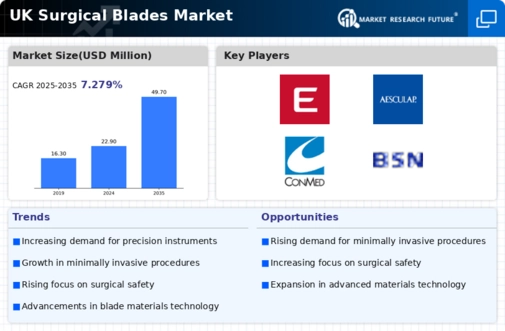The surgical blades market exhibits a competitive landscape characterized by a blend of innovation, strategic partnerships, and regional expansion. Key players such as B. Braun Melsungen AG (DE), Johnson & Johnson (US), and Smith & Nephew plc (GB) are actively shaping the market dynamics. B. Braun Melsungen AG (DE) focuses on enhancing its product portfolio through continuous innovation, particularly in the development of advanced surgical instruments. Johnson & Johnson (US) emphasizes strategic acquisitions to bolster its market presence, while Smith & Nephew plc (GB) is concentrating on digital transformation initiatives to improve operational efficiency and customer engagement. Collectively, these strategies contribute to a competitive environment that is increasingly driven by technological advancements and customer-centric approaches.
In terms of business tactics, companies are localizing manufacturing to reduce lead times and optimize supply chains. The market structure appears moderately fragmented, with several players vying for market share. However, the influence of major companies is substantial, as they leverage their resources to establish a competitive edge. This fragmentation allows for niche players to emerge, yet the dominance of key players like Medtronic plc (IE) and Stryker Corporation (US) remains evident, as they continue to innovate and expand their offerings.
In October 2025, Medtronic plc (IE) announced a strategic partnership with a leading technology firm to integrate AI capabilities into its surgical blade manufacturing processes. This move is likely to enhance precision and efficiency in production, aligning with the growing trend of digitalization in the healthcare sector. Such advancements may position Medtronic as a frontrunner in the market, potentially increasing its market share.
In September 2025, Stryker Corporation (US) launched a new line of eco-friendly surgical blades, reflecting a commitment to sustainability. This initiative not only addresses environmental concerns but also caters to the increasing demand for sustainable medical products. By prioritizing eco-friendly solutions, Stryker could differentiate itself in a competitive market, appealing to environmentally conscious healthcare providers.
In August 2025, Smith & Nephew plc (GB) expanded its operations in the UK by investing in a state-of-the-art manufacturing facility. This investment is indicative of the company's strategy to enhance production capabilities and meet the rising demand for surgical blades. By localizing production, Smith & Nephew may improve supply chain reliability and reduce costs, thereby strengthening its competitive position.
As of November 2025, the surgical blades market is witnessing trends such as digitalization, sustainability, and AI integration, which are redefining competitive dynamics. Strategic alliances are increasingly shaping the landscape, enabling companies to pool resources and expertise. Looking ahead, competitive differentiation is likely to evolve from traditional price-based competition to a focus on innovation, technology, and supply chain reliability. Companies that can effectively leverage these trends may secure a more prominent position in the market.















Leave a Comment